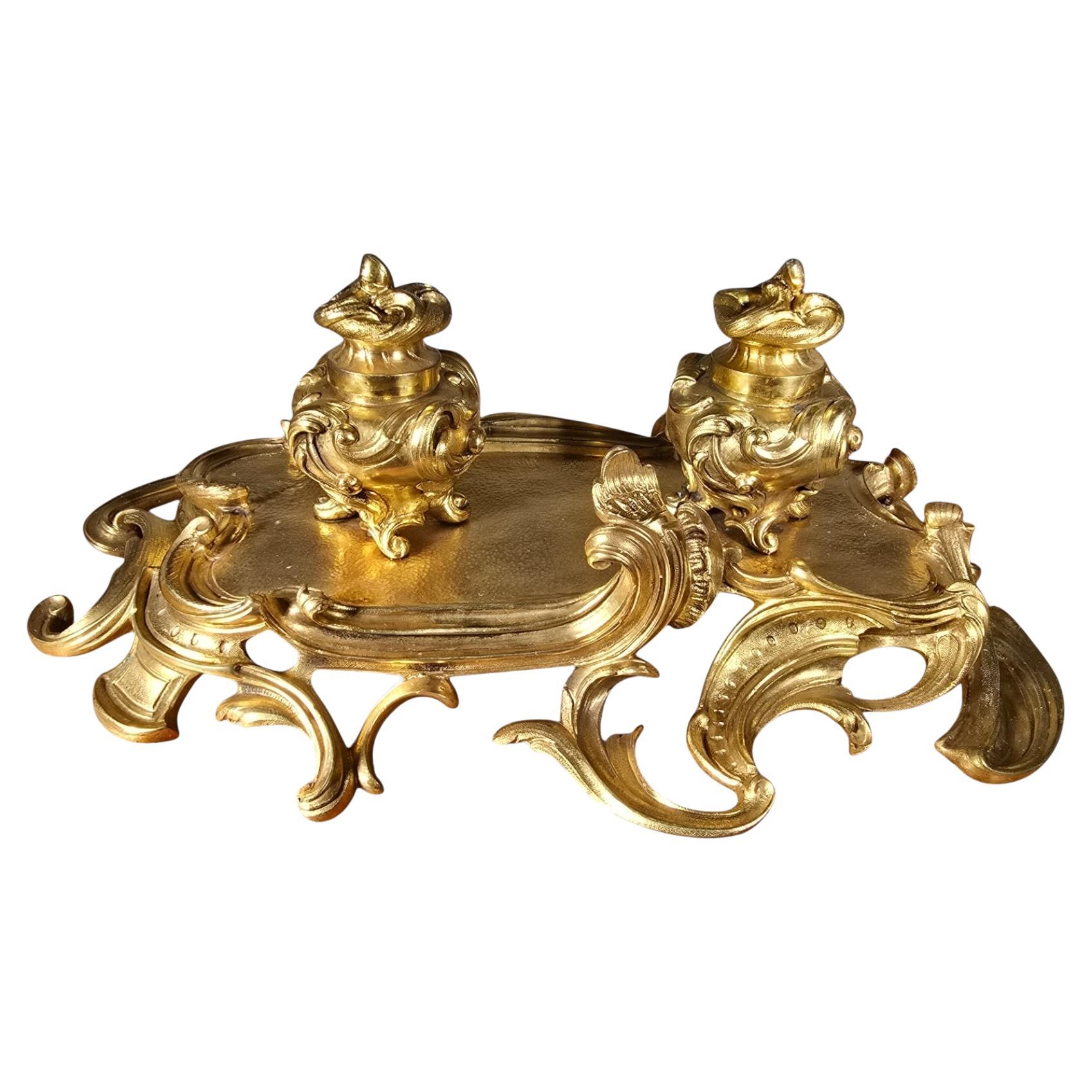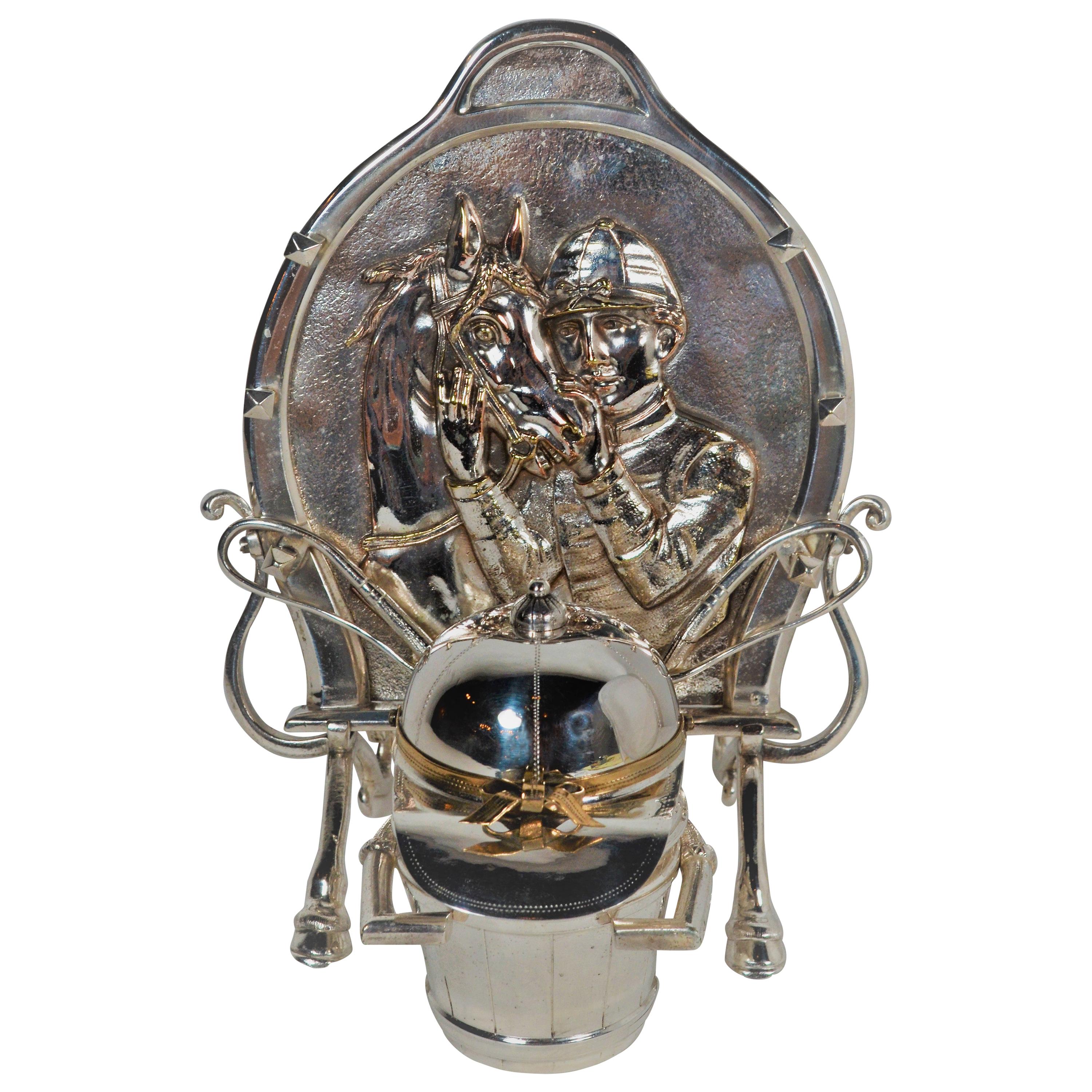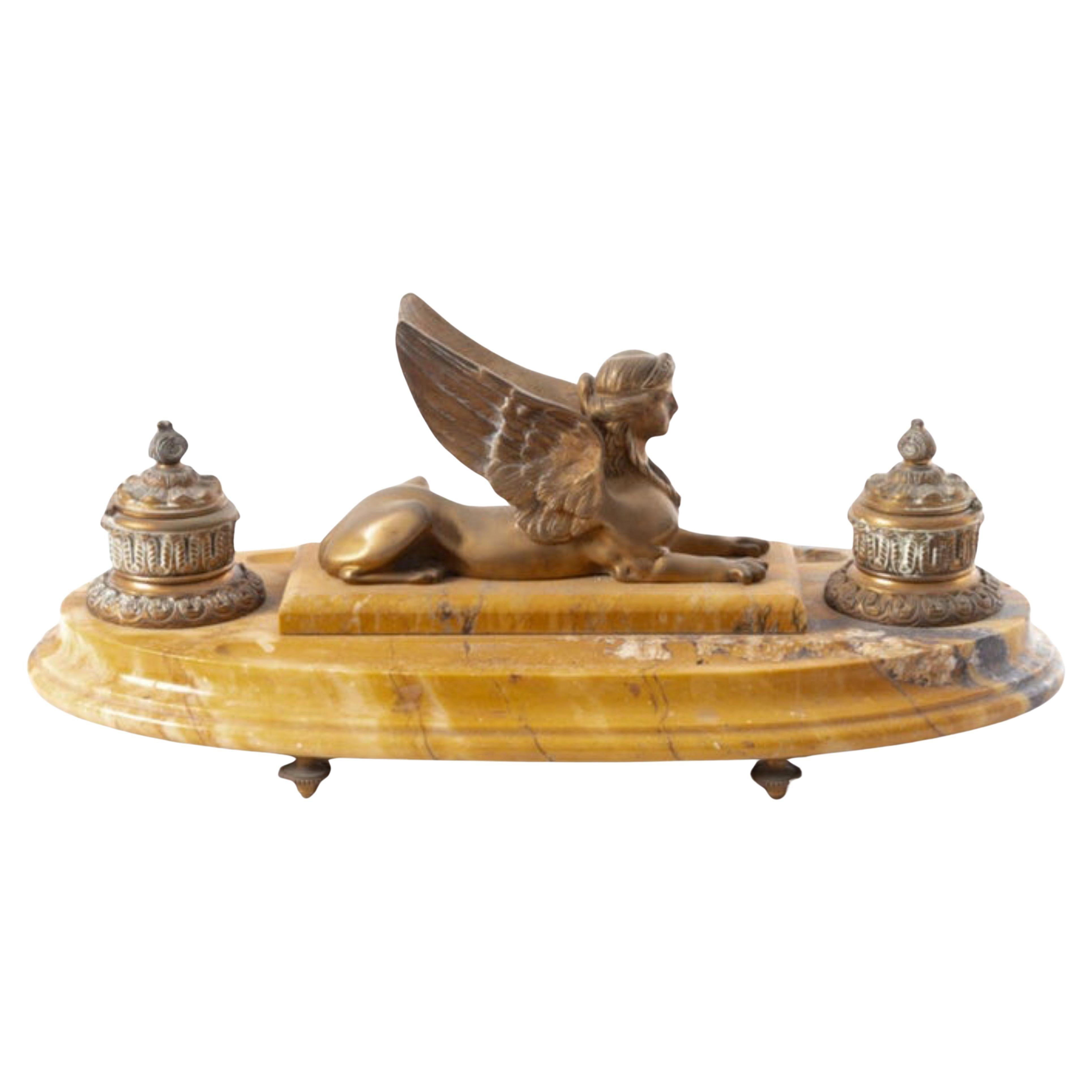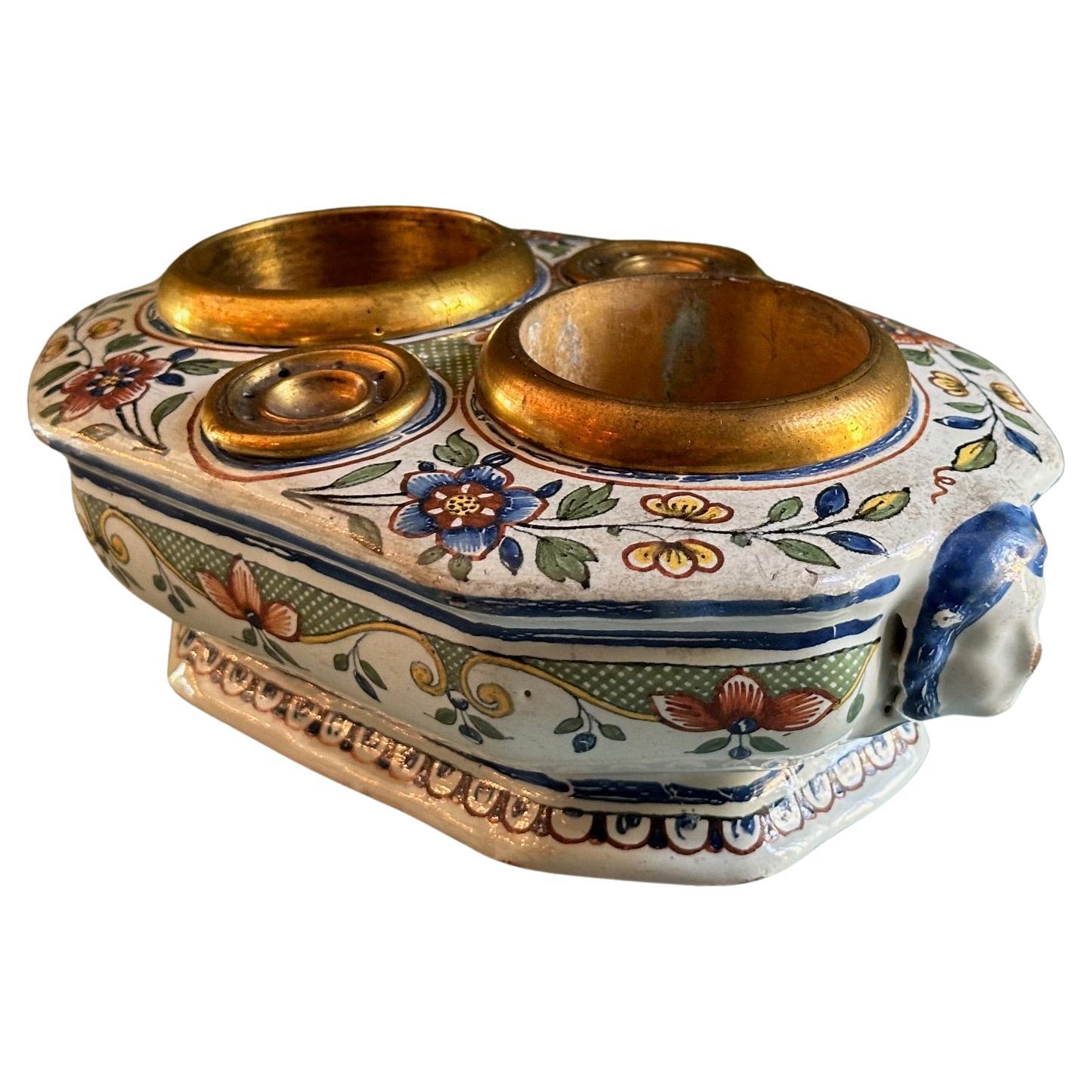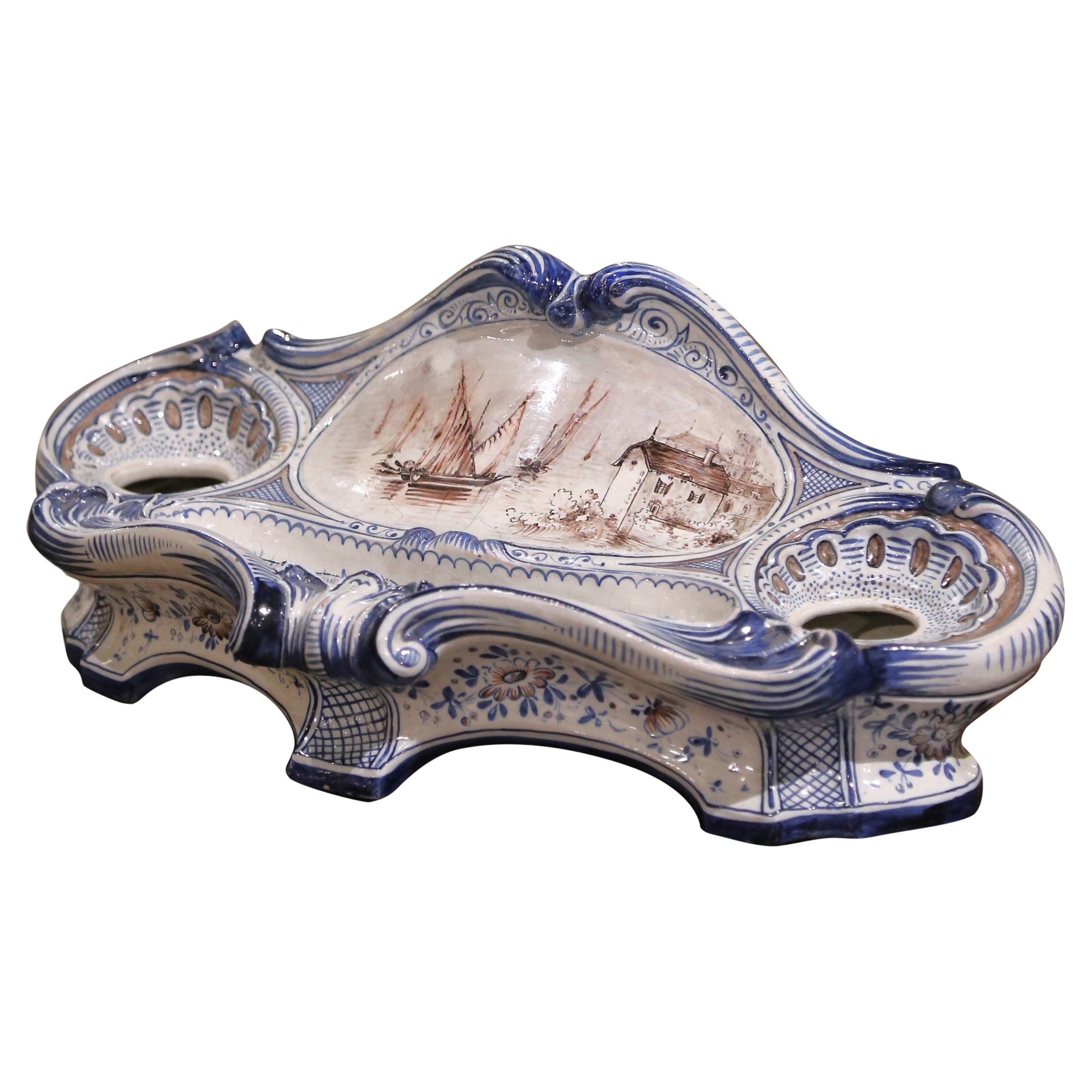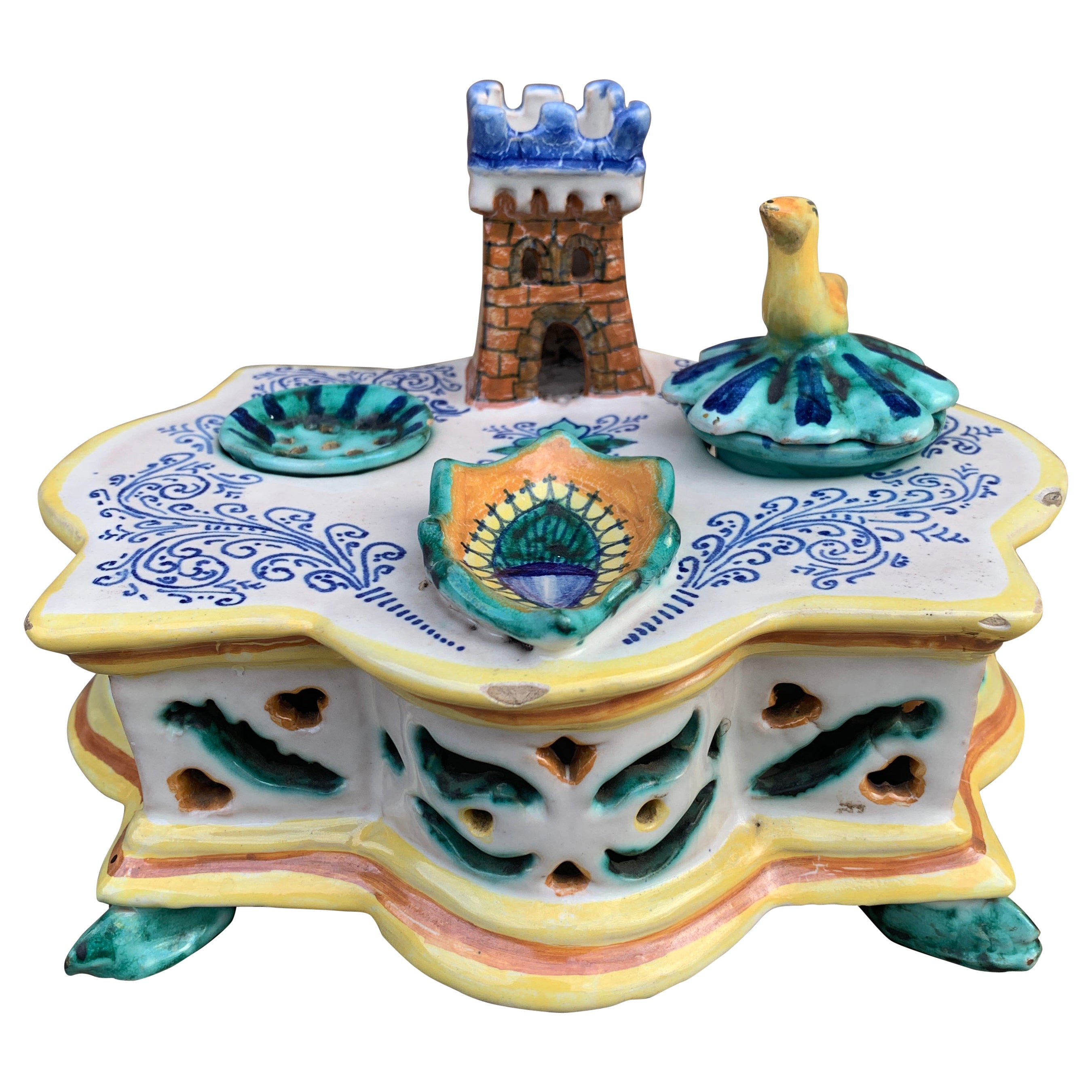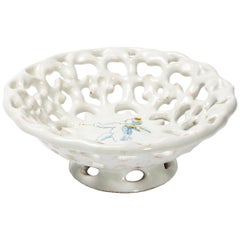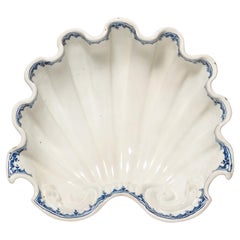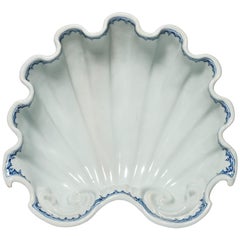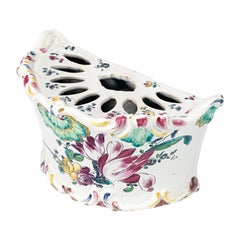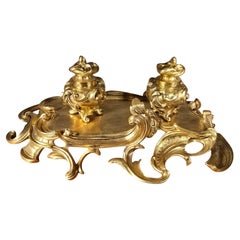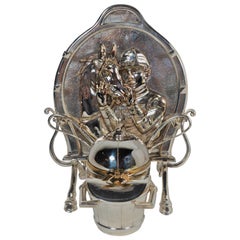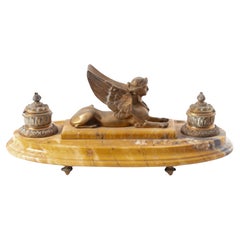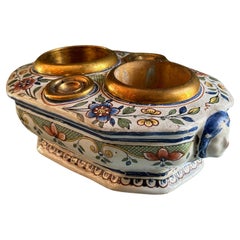Articoli simili a Renaissance Inkwell Calamelli workshop, Italy, Faenza, second half of the 16th
Caricamento del video
Vuoi altre immagini o video?
Richiedi altre immagini o video al venditore
1 di 20
Renaissance Inkwell Calamelli workshop, Italy, Faenza, second half of the 16th
16.000� €IVA inclusa
Informazioni sull’articolo
Inkwell
Calamelli workshop (attr.).
Faenza, second half of the 16th century
Height 4.33 in; length 8.07 in; depth 2.95 in (11 cm; 20.5 cm; 7.5 cm)
Weight: 0.800 lb (363 g)
State of conservation: some chipping to the top of the mask around the mouth. Handle glued, without any restorations; minor chips in some raised areas.
This object has the shape of a foot wearing Greek-style footwear, as can be seen in some raised areas. The foot is anatomically modeled with bare toes, while the ankle is partially covered by the footwear. On the heel, there is a small circular handle to support the object. The mouth of the container is shaped like a mask. The interior, completely enamelled, suggests that the piece was intended to be used as an inkwell or to contain some other liquid. The base, however, is not enamelled.
The painted decoration, scant and brief, consists of rapid cobalt blue shading between the toes of the foot, with more precise emphasis on the nails. It is accompanied by yellow citrine accents to enhance the forms. The mask is painted with the tip of the brush, to accentuate the tense nature of the eyes and to accentuate their outline. Thin strokes of yellow-orange line the interior of the mouth.
Since the Renaissance, this decoration has been referred to as "compendiaria" and it characterizes the period of production extending from the mid-16th century to approximately the middle of the following century. It significantly influenced tastes at the time. It evolved from the polychrome style “istoriato” and transformed into a new style that "summarized" (compendia), or condensed, the ornamentation of the works into a few colors, placing greater prominence on the shapes. It was often inspired by metal specimens. Since the Renaissance, this decoration has been referred to as "compendiaria" and it characterizes the period of production extending from the mid-16th century to approximately the middle of the following century. It significantly influenced tastes at the time. It evolved from the polychrome style “istoriato” and transformed into a new style that "summarized" (compendia), or condensed, the ornamentation of the works into a few colors, placing greater prominence on the shapes. It was often inspired by metal specimens.
This artwork finds parallels in similar objects all characterized by this refined style and produced in the city of Faenza and other Italian centres starting from the mid-16th century.
The closest comparable example in maiolica is a foot acquired by the British Museum in 2011 (inv. 2011, 8008.1). This was previously published by Carmen Ravanelli Guidotti in 1996 and later by Dora Thornton in 2016 during the conference on Renaissance ceramics in Assisi.
The artwork in the British Museum bears the inscription "VR. FA" underneath the base, associated with Virgiliotto Calamelli. It is characterized by a "compendiaria" decoration that focuses on the form of the footwear adorned with leaves, coloring them in yellow-orange. On the other hand, our foot, which is morphologically very similar, leaves the raised footwear uncolored, shading only certain areas with a watercolor-style effect.
In addition to the painted decoration, the comparison between these two works demonstrates other subtle differences, such as the particularly unique finishing of the ceramics performed upon removal from the mold: notice the mouthpiece, which is oval on our specimen while round on the one from the British Museum. The mask of this latter piece features a pair of goat horns on its head and has a wide hooked nose, curled moustaches, and an uncombed beard. On the other hand, the grotesque face of our foot, which has lost the decoration on its head, has less sculptural features, with a prevalence of textured enamel, clearly visible in the drops of the decoration.
The production style of our maiolica, coupled with the lack of signatures, does not exclude the possibility of a broader attribution to other contemporary Faenza workshops.
In this regard, it is useful to recall how we often find morphologically similar works initialed by different Faenza workshops and how in these areas of production the active craftsmen were numerous, so much so that it is difficult to recognize the various artistic personalities to which individual works can be traced. It is also important to underline how the workshops worked in parallel with the more well-known ones of Calamelli, Mezzarisa, Bettisi, and Utili, all equally engaged in the revolution of taste during the "compendiario" period.
Thus, among the inventory documents, we find detailed lists regarding “credenze” ordered from the Faenza workshops which have similar forms but bear different signatures. For example, the salt shaker “a dolphin” was produced in both white enamel by the Calamelli and Bettisi workshops and with a “berettino” background by the Utili workshop. (C. Ravanelli Guidotti, Bianchi di Faenza, Ferrara, 1996, p. 210 n. 46 e p. 236 n. figg. 3a-3b).
The exchange of molds among the various workshops is also detectable in a range of works similar to ours in taste and cultural intent: boot-shaped pourers with a mouthpiece in the guise of a lion's head, a form that draws inspiration from pewter or glass models (C. Ravanelli Guidotti, op. cit., 1996, p. 492 n. 140). However, there is a single example known with the signature "Do Pi," which stands for Don Pino, dating between 1570 and 1580, now at Waddesdon Manor (inv. 7119). This fact could suggest that the mold was passed from the workshop of Virgiliotto Calamelli to that of Leonardo Bettisi, also known as Don Pino, when he took over the activity after 1570. (T. Wilson, in L. Hollein, R. Franz, T. Wilson, editors, Tin Glaze and Image Culture The Mak maiolica collection in its wider context, Vienna 2022, p.135, n. 87. D. Thornton, in Giulio Busti, Mauro Cesaretti, Franco Cocchi, editors, La maiolica italiana del Rinascimento: studi e ricerche. Atti del convegno internazionale, Assisi, 9-11 settembre 2016, pp. 66-69).
Regarding the shape of the artwork under examination, the model of inspiration has been the subject of numerous hypotheses put forth by scholars. Maiolica feet are refined and sought-after artifacts that, along with votive bronzes or classically inspired bronzes, characterized a long tradition of imitation during the Renaissance (Warren J. in Marino M., eds., Fabulae pictae: myths and stories in Renaissance maiolica, Florence 2012). This tradition can be attributed to the demand for "antique-style" works as ornaments, alongside ancient originals, for the desks of Renaissance gentlemen. The Faenza potters actively responded to this demand with "the curious predilection of those maiolica makers for strange shapes: hammers, violins, pyramids, clogs and shoes, cages, etc." (G. Liverani Un raro cimelio di maiolica faentina. Faenza XL, 1954 fasc. II pp. 30-33). The hypothesis that associates the container with Roman lamps in the shape of a shod foot is particularly convincing: these were widespread in the first two centuries AD and possibly connected to the oriental cult of Serapis.
Moreover, the functionality of these works varied depending on the choices of details applied to the molds, which could alter their use. An example that testifies to this is a maiolica foot from Deruta, adorned with stigmas, wearing a flat-soled sandal with a wide-open mouth-shaped spout and equipped with a hole for the liquid to flow out from the tip of the big toe. This characteristic is more consistent with a”tazza ad inganno” (Trick cup) or "bevi se puoi" (Drink if you can) cup, despite the comparable artwork, which passed through the antique market (C. Ravanelli Guidotti, op. cit., 1996, p. 546 n. 168). It recalls, as a source of inspiration, a golden bronze lamp in the shape of a foot at the Correr Museum in Venice (XI,102), probably by Andrea Biosco, also known as Riccio (G. Mariacher, Bronzetti veneti del Rinascimento, Vicenza 1971, pp.28, n. 73, fig. 73). The same model is found with variations in two Deruta pieces from the Campana collection at the Louvre: the first foot with an outlet hole on the heel (Inv. OA 1823) can be interpreted as a Trick cup, and the other one, with a more sober shape, can be used as an inkwell (Inv. OA 1242).
Our simple and unadorned foot, as well as the one at the British Museum, is likely intended for use as an inkwell. The very simplicity in execution, despite the lack of signatures, suggests an attribution to the Faenza workshop of Virgiliotto Calamelli, supported by archival documents containing inventories of the workshop, published by Grigioni in 1934. In these inventories, dated 1556, among the listed items of various forms, "2 piedi" (2 feet) are mentioned, clearly referring to the presence of two examples of such shape in the workshop.
In any case, this artwork belongs to the context of learned curiosities typical of the late Renaissance period, many of which find ample expression in the exquisite Faenza productions. These productions were strongly engaged in the great revolution of taste represented by the "bianchi" (D. Thornton 2016, op. cit., pp. 69-80).
Bibliography:
C. Ravanelli Guidotti, Bianchi di Faenza, Ferrara, 1996, p. 128 n. 20;
D. Thornton, in Giulio Busti, Mauro Cesaretti, Franco Cocchi, editors, La maiolica italiana del Rinascimento: studi e ricerche. Atti del convegno internazionale, Assisi, 9-11 settembre 2016, pp. 63-82;
C. Grigioni, Documenti… I C. maiolicari…, in Faenza, XXII (1934), pp. 50-54, 88-90, 143-153;
Warren J. in Marino M., editor, Fabulae pictae: miti e storie nelle maioliche del Rinascimento, Firenze 2012;
G. Mariacher, Bronzetti veneti del Rinascimento, Vicenza 1971, pp.28, n. 73, fig. 73;
G. Liverani Un raro cimelio di maiolica faentina. Faenza XL, 1954 fasc. II pp. 30-33;
T. Wilson, in L Hollein, R. Franz, T. Wilson, editors., Tin Glaze and Image Culture The Mak maiolica collection in its wider context, Vienna 2022, p.135, n. 87;
G. Vasari, Le vite de' più eccellenti pittori, scultori e architettori, 1568.
- Attribuito a:Virgiliotto Calamelli (Laboratorio/Atelier)
- Dimensioni:Altezza: 11 cm (4,34 in)Larghezza: 20,5 cm (8,08 in)Profondità: 7,5 cm (2,96 in)
- Stile:Rinascimento (Del periodo)
- Materiali e tecniche:Maiolica
- Luogo di origine:
- Periodo:XVI secolo
- Data di produzione:Circa 1570
- Condizioni:Riparato: Handle glued, without any restorations. Usura compatibile con l’età e l’utilizzo. Lievi mancanze. Some chipping to the top of the mask around the mouth. Handle glued, without any restorations; minor chips in some raised areas.
- Località del venditore:Milano, IT
- Numero di riferimento:1stDibs: LU4352237965332
Informazioni sul venditore
4,3
Venditore professionale selezionato
Ogni venditore supera rigorosi standard di autenticità e affidabilità
Fondazione nel 1860
Venditore 1stDibs dal 2018
21 vendite su 1stDibs
Associazioni
International Confederation of Art and Antique Dealers' Associations
- SpedizioneRecupero del preventivo…Spedizione da: Milano, Italia
- Politica di reso
Alcune parti di questa pagina sono state tradotte automaticamente. 1stDibs non può garantire che le traduzioni siano corrette. L’inglese è la lingua predefinita del sito.
Garanzia di autenticità
Nell’improbabile caso in cui si verifichi un problema con l’autenticità di un articolo, contattaci entro un anno per ottenere un rimborso completo. DettagliGaranzia di rimborso
Se il tuo articolo non corrisponde alla descrizione, è danneggiato durante il trasporto o non arriva, contattaci entro 7 giorni per un rimborso completo. DettagliAnnullamento entro 24 ore
Hai un periodo di tolleranza di 24 ore per annullare il tuo acquisto, senza necessità di fornire spiegazioni.Venditori professionali selezionati
I nostri venditori di livello internazionale devono aderire a rigorosi standard di servizio e qualità, garantendo l’integrità delle inserzioni.Garanzia miglior prezzo
Se scopri che un venditore ha pubblicato altrove lo stesso articolo a un prezzo più basso, applicheremo lo stesso prezzo.Consegna globale affidabile
La nostra rete di vettori leader del settore offre opzioni di spedizione specializzate in tutto il mondo, inclusa la consegna personalizzata.Altro da questo venditore
Mostra tuttoAntica Maiolica rinascimentale italiana Crespina, Faenza, 1580 circa
Crespina
Faenza, ultimo quarto del XVI secolo
Maiolica dipinta in due colori, azzurro e giallo, su uno spesso e ricco strato di smalto bianco.
Misura 2,24 pollici (5,7 cm) di altezza...
Categoria
Di antiquariato/d’epoca, XVI secolo, Italiano, Rinascimento, Ceramiche
Materiali
Maiolica
Antica Maiolica Italiana Faenza, Ferniani Factory, Circa 1700
Di Ferniani Factory
Centrotavola in maiolica bianca
Ferniani Factory, primo periodo: 1693-1776
Faenza, circa 1700
Misure: 5.6 in x 14.72 in x 13.46 in (14.3 cm x 37.4 cm x cm 34.2)
lb 4,4 ciascuno (kg ...
Categoria
Di antiquariato/d’epoca, Inizio Settecento, Italiano, Barocco, Ceramiche
Materiali
Maiolica
Antica Maiolica Italiana Faenza, Ferniani Factory, Circa 1700
Di Ferniani Factory
Centrotavola in conchiglia di maiolica blu chiaro
Ferniani Factory, primo periodo: 1693-1776
Faenza, 1700 circa
5,5 in x 14,72 in x 13,77 in (14 cm x 37,4 cm X cm 35)
lb 4,40 (kg 2)
...
Categoria
Di antiquariato/d’epoca, Inizio Settecento, Italiano, Barocco, Ceramiche
Materiali
Maiolica
Antico vaso da fiori in maiolica Fabbrica Pasquale Rubati, Milano Circa 1770
Di Pasquale Rubati
Vaso da fiori in maiolica "a mezzaluna" decorato con tulipani
Fabbrica di Pasquale Rubati
Milano, 1770 circa.
Misure: 4,7 pollici x 4,7 pollici x 8,6 pollici
12 cm x 12 cm x 22 cm...
Categoria
Di antiquariato/d’epoca, Anni 1770, Italiano, Rococò, Ceramiche
Materiali
Maiolica
Vaso da fiori in maiolica rococò italiano Pasquale Rubati, Milano, 1770 circa
Di Pasquale Rubati
Vaso da fiori in maiolica "a mezzaluna" con piedi di appoggio
decorato con piccoli mazzi di fiori
Fabbrica di Pasquale Rubati
Milano, 1770 circa
5.5 in X 5 in X 8.6 in
14 cm x 12,...
Categoria
Di antiquariato/d’epoca, Anni 1770, Italiano, Rococò, Ceramiche
Materiali
Maiolica
Antica tazza in maiolica, manifattura Rubati, Milano, circa 1770 - 1780
Di Pasquale Rubati
Tazza malata
Pasquale Rubati Produzione
Milano, circa 1770 - 1780
Maiolica decorata in policromia "a piccolo fuoco" (terzo fuoco)
Le misure sono: h 2,36 x 7,4 x 7,87 (h 6 x 19 x ...
Categoria
Di antiquariato/d’epoca, Anni 1770, Italiano, Rococò, Ceramiche
Materiali
Maiolica
Ti potrebbe interessare anche
Calamaio francese in stile barocco, XIX secolo
Un elegante calamaio francese realizzato in bronzo dorato in stile barocco del XIX secolo. Questo lussuoso pezzo riflette l'arte intricata e l'opulenza tipica dell'arredamento di isp...
Categoria
Di antiquariato/d’epoca, Anni 1850, Calamai
Materiali
Bronzo
Antico calamaio e portapenne inglese vittoriano
Un piccolo pezzo affascinante
Categoria
Di antiquariato/d’epoca, Fine XIX secolo, Inglese, Calamai
Materiali
Placcato argento
Calamaio FABBRICAZIONE FRANCESE DELL'INIZIO DEL XX SECOLO
Calamaio
FABBRICAZIONE FRANCESE DELL'INIZIO DEL NOVEMBRE
Calamaio in stile impero in marmo giallo di Siena con calamai e sfinge in bronzo dorato.
48 x 23 cm Altezza 20.
Categoria
Inizio XX secolo, Francese, Napoleone III, Calamai
Materiali
Marmo
A.I.C. Antico ufficio da tavolo con calamaio, pezzo centrale in porcellana Faience del XIX secolo
A.I.C. Antico ufficio da tavolo con calamaio, pezzo centrale in porcellana Faience. Questa bellissima decorazione su una scrivania, un tavolo o una consolle aggiungerà un'eleganza im...
Categoria
Di antiquariato/d’epoca, Inizio XIX secolo, Europeo, Calamai
Materiali
Ottone, Bronzo
3132 € Prezzo promozionale
25% in meno
Calamaio francese del XIX secolo Luigi XV dipinto a mano in stile Delft Vide-Poche
Di Delft
Questo calamaio in ceramica dalla forma unica è stato scolpito in Francia, intorno al 1880. L'essenziale da scrivania a forma di cartiglio presenta un medaglione centrale dipinto a m...
Categoria
Di antiquariato/d’epoca, Fine XIX secolo, Francese, Luigi XV, Calamai
Materiali
Ceramica, Faenza
Calamaio provinciale italiano di Deruta dipinto a mano con figure allegoriche
Di Deruta
Un bellissimo calamaio da tavolo in ceramica faience Allegorical dipinto a mano in blu, bianco, giallo e verde, con un castello, un uccello e dei disegni fogliacei.
Da Deruta
Itali...
Categoria
Inizio XX secolo, Italiano, Stile provenzale, Delft e Faïence
Materiali
Faenza, Terracotta
